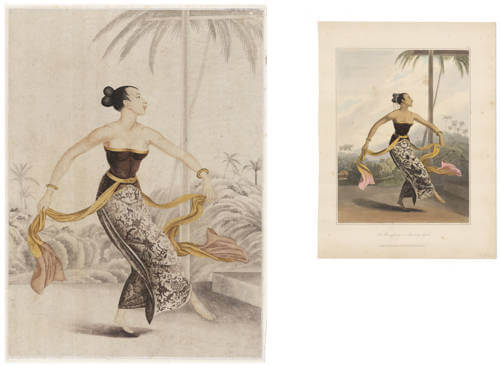Leen Helmink Antique Maps
Old books, maps and prints by William Daniell
William Daniell (1769–1837)
William Daniell was one of the most accomplished and prolific landscape and marine painters of the Romantic era in Britain. Renowned for his finely detailed depictions of coastal scenes and exotic locales, Daniell’s art served not only aesthetic purposes but also functioned as visual documentation of Britain's expanding empire. His unique career spanned from Indian courtly grandeur to the rugged coastlines of Scotland, and his works combined the sensibilities of the picturesque with the observational rigor of a traveler-artist. Among his many accomplishments, his illustrations for Sir Stamford Raffles’ History of Java stand out as a testament to his ability to translate unfamiliar Eastern settings into compositions both faithful and appealing to European audiences.
Early Life and Training
William Daniell, born in 1769 in Kingston upon Thames, Surrey, was an English landscape and marine painter and printmaker renowned for his mastery of aquatint. His early life was marked by tragedy when his father, a bricklayer and publican, died in 1779. Orphaned at ten, William was sent to live with his uncle, Thomas Daniell (1749–1840), a landscape painter with a passion for Orientalist themes. This pivotal moment shaped William’s future, as Thomas became both guardian and mentor, introducing him to the world of art.
At fifteen, William accompanied Thomas on a transformative journey to India (1785–1794), serving initially as an assistant. During this near-decade-long expedition, William honed his skills in sketching and aquatint, a delicate printmaking technique ideal for capturing atmospheric effects. The duo traveled extensively across the Indian subcontinent, documenting its landscapes, architecture, and cultures with a camera obscura. William kept a detailed diary of their travels, now housed in the British Library, which provides a vivid record of their experiences. By the time they returned to London in 1794, William had evolved from apprentice to equal partner, his artistic abilities refined by the rigors of their journey.
Artistic Career and Oriental Scenery
Upon returning to England, William and Thomas settled at 37 Howland Street, Fitzroy Square, and embarked on their magnum opus, Oriental Scenery (1795–1808). This ambitious six-part series, comprising 144 colored aquatints, showcased India’s landscapes, temples, and daily life with unprecedented detail. William’s aquatint expertise brought vividness to the scenes, earning praise for their fidelity and artistry. The project, costing £210 per set, was a commercial and artistic triumph, with thirty sets purchased by the East India Company. The Calcutta Monthly magazine lauded the work’s “masterly execution” and its ability to evoke the “warmth of an Indian sky.” Oriental Scenery not only popularized a romanticized vision of India but also influenced British decorative arts and architecture.
William entered the Royal Academy Schools in 1799, exhibiting 168 works—mostly landscapes—between 1795 and 1838. His paintings often diverged from his uncle’s focus on broad landscapes, favoring intimate scenes of people by water or imaginative Oriental motifs. He became an Associate of the Royal Academy in 1807 and a full Royal Academician in 1822, a testament to his growing stature.
Illustrations for The History of Java
In 1817, William Daniell contributed significantly to Sir Stamford Raffles’ The History of Java, a seminal work on Indonesian culture and history. Raffles, Lieutenant-Governor of Java (1811–1816), aimed to contrast British benevolence with Dutch colonial policies. The first edition, published in 900 copies, included 66 plates, ten of which were hand-colored aquatints by William depicting Javanese life, costumes, and a Papuan boy who accompanied Raffles to England. These unsigned plates, attributed to Daniell for their stylistic resemblance to his work, captured the vibrancy of Javanese culture with meticulous detail. The second edition (1830–1844) expanded to 92 plates, incorporating additional Javanese antiquities and topography, many credited to Daniell.
Daniell’s illustrations, such as A Ronggeng or Dancing Girl and A Peng’anten Lanang or Bridegroom, were celebrated for their ethnographic precision and picturesque qualities. Art historian Dr. Sarah Tiffin noted that Daniell’s depiction of a Dieng Plateau temple, adapted from Dutch drawings, introduced lush foliage to evoke the transient nature of human achievement, aligning with British imperial narratives. The aquatints’ vivid colors and intricate details made The History of Java a masterpiece, with bibliographer John Bastin calling it “one of the most important and influential books about Indonesia ever published.”
A Voyage Round Great Britain
Around 1813, William embarked on another monumental project, A Voyage Round Great Britain (1814–1825), a visual chronicle of Britain’s coastline. Traveling in six-month stages due to weather, he collaborated initially with writer Richard Ayton, whose prose complemented William’s aquatints. After parting ways in 1814, William completed the journey alone, producing sketches that he later refined in London. The project, spanning a decade, resulted in eight volumes of aquatints renowned for their atmospheric depth and maritime detail. Works like Mivagissey, Cornwall and Dover, from Shakespeare’s Cliff showcased his ability to capture the sublime beauty of Britain’s shores. This endeavor, considered his greatest artistic legacy, demonstrated his remarkable memory and dedication, as some prints were completed years after the initial sketches.
Later Life and Legacy
William’s later years were marked by continued productivity. He engraved plates for his brother Samuel’s Sketches of Southern Africa (1820) and produced 72 etchings for George Dance’s A Collection of Portraits (1804–1814). His marine paintings, such as The Burning of the “Kent”, highlighted his skill in depicting dramatic seascapes. Joseph Farington, a friend and fellow artist, noted William’s relentless work ethic, reportedly laboring from 6 a.m. to midnight for seven years to perfect his craft.
William Daniell died in 1837, leaving a legacy of technical brilliance and cultural documentation. His aquatints for Oriental Scenery, The History of Java, and A Voyage Round Great Britain remain benchmarks of early 19th-century printmaking. By blending artistic skill with ethnographic and topographical precision, Daniell not only captured the landscapes and peoples of his time but also shaped Britain’s visual understanding of its empire and its own shores.
